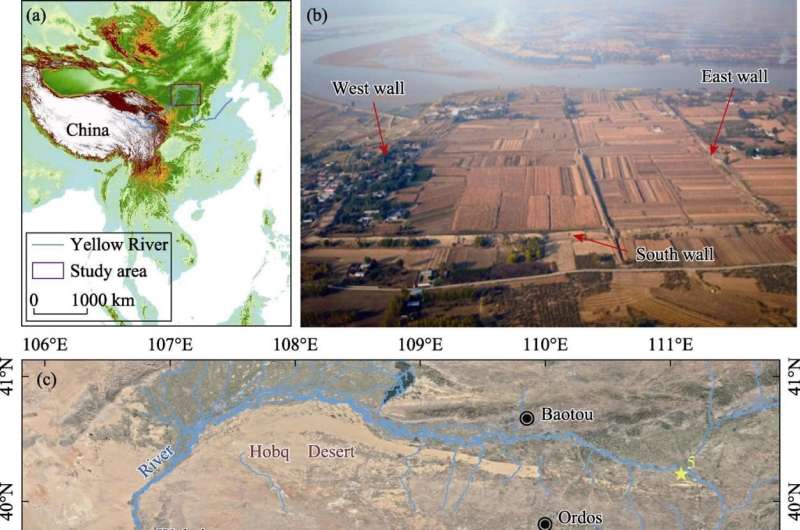Deciphering the patterns of human settlements on the Ordos Plateau
The Ordos Plateau, a distinctive geomorphic entity in China, has been a cradle of human civilization since the late Paleolithic era. Its unique geographical and climatic conditions have fostered a rich tapestry of human history, reflected in the settlement patterns that have evolved over thousands of years.
In a recent study published in the Journal of Geographical Sciences, researchers from Lanzhou University meticulously analyzed the spatial and temporal characteristics of settlements on the Ordos Plateau since the Neolithic Age.
They found that the settlements predominantly clustered in the southern and eastern parts of the plateau, areas less affected by the deserts. The settlement sizes varied, with most being small to medium, and a few larger ones.
The spatial distribution displayed fractal characteristics, indicating an agglomerated pattern. This study also discovered that the frequency of these settlements underwent periodic fluctuations, influenced by various natural factors such as climate change, hydrology, and topography. Human factors, including socio-political dynamics, wars, and changes in subsistence strategies, also played a significant role.
The study concludes that the Ordos Plateau’s human settlements were a product of complex interactions between natural environments and human activities. These settlements serve as a historical record, reflecting how humans have adapted to and influenced their surroundings.
Professor Wang Nai’ang, the corresponding author of this article, said, “This research provides unprecedented insights into the resilience and adaptability of human societies in the face of environmental challenges. It underscores the profound impact of climate and socio-political forces in shaping human settlements over millennia.”
This research not only contributes to our understanding of historical human-land relationships in the Ordos Plateau but also offers valuable lessons for modern society in terms of sustainable living and environmental management.
The findings highlight the importance of a holistic approach that considers both natural and human factors in studying human settlements.
More information:
Penghui Wen et al, Human settlements in the Ordos Plateau since the Neolithic Age, Journal of Geographical Sciences (2023). DOI: 10.1007/s11442-023-2179-6
Citation:
Deciphering the patterns of human settlements on the Ordos Plateau (2024, January 24)
retrieved 24 January 2024
from https://phys.org/news/2024-01-deciphering-patterns-human-settlements-ordos.html
This document is subject to copyright. Apart from any fair dealing for the purpose of private study or research, no
part may be reproduced without the written permission. The content is provided for information purposes only.

The Ordos Plateau, a distinctive geomorphic entity in China, has been a cradle of human civilization since the late Paleolithic era. Its unique geographical and climatic conditions have fostered a rich tapestry of human history, reflected in the settlement patterns that have evolved over thousands of years.
In a recent study published in the Journal of Geographical Sciences, researchers from Lanzhou University meticulously analyzed the spatial and temporal characteristics of settlements on the Ordos Plateau since the Neolithic Age.
They found that the settlements predominantly clustered in the southern and eastern parts of the plateau, areas less affected by the deserts. The settlement sizes varied, with most being small to medium, and a few larger ones.
The spatial distribution displayed fractal characteristics, indicating an agglomerated pattern. This study also discovered that the frequency of these settlements underwent periodic fluctuations, influenced by various natural factors such as climate change, hydrology, and topography. Human factors, including socio-political dynamics, wars, and changes in subsistence strategies, also played a significant role.
The study concludes that the Ordos Plateau’s human settlements were a product of complex interactions between natural environments and human activities. These settlements serve as a historical record, reflecting how humans have adapted to and influenced their surroundings.
Professor Wang Nai’ang, the corresponding author of this article, said, “This research provides unprecedented insights into the resilience and adaptability of human societies in the face of environmental challenges. It underscores the profound impact of climate and socio-political forces in shaping human settlements over millennia.”
This research not only contributes to our understanding of historical human-land relationships in the Ordos Plateau but also offers valuable lessons for modern society in terms of sustainable living and environmental management.
The findings highlight the importance of a holistic approach that considers both natural and human factors in studying human settlements.
More information:
Penghui Wen et al, Human settlements in the Ordos Plateau since the Neolithic Age, Journal of Geographical Sciences (2023). DOI: 10.1007/s11442-023-2179-6
Citation:
Deciphering the patterns of human settlements on the Ordos Plateau (2024, January 24)
retrieved 24 January 2024
from https://phys.org/news/2024-01-deciphering-patterns-human-settlements-ordos.html
This document is subject to copyright. Apart from any fair dealing for the purpose of private study or research, no
part may be reproduced without the written permission. The content is provided for information purposes only.
